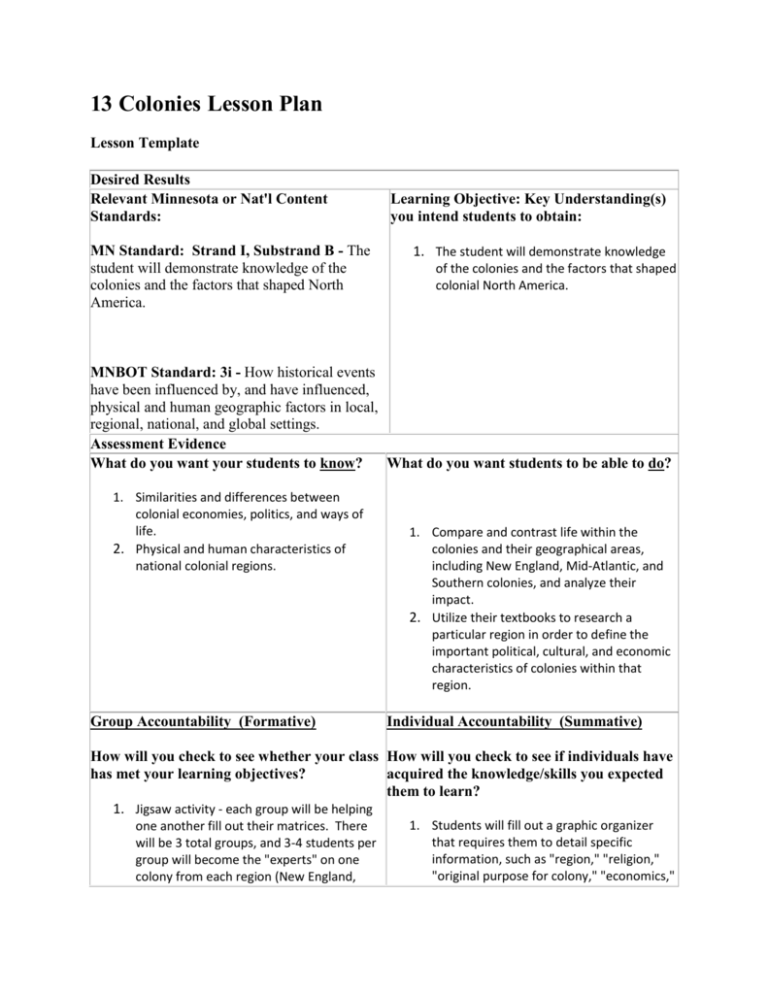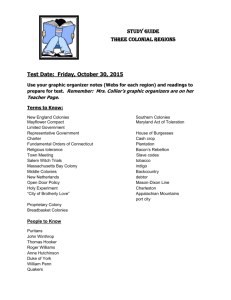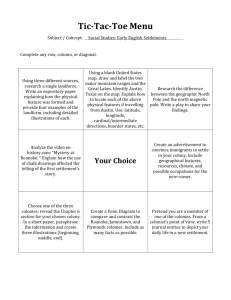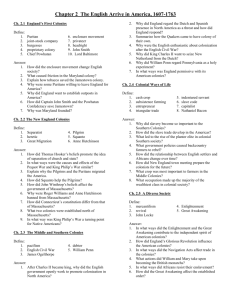13 Colonies Lesson Plan
advertisement

13 Colonies Lesson Plan Lesson Template Desired Results Relevant Minnesota or Nat'l Content Standards: MN Standard: Strand I, Substrand B - The student will demonstrate knowledge of the colonies and the factors that shaped North America. Learning Objective: Key Understanding(s) you intend students to obtain: 1. The student will demonstrate knowledge of the colonies and the factors that shaped colonial North America. MNBOT Standard: 3i - How historical events have been influenced by, and have influenced, physical and human geographic factors in local, regional, national, and global settings. Assessment Evidence What do you want your students to know? What do you want students to be able to do? 1. Similarities and differences between colonial economies, politics, and ways of life. 2. Physical and human characteristics of national colonial regions. Group Accountability (Formative) 1. Compare and contrast life within the colonies and their geographical areas, including New England, Mid-Atlantic, and Southern colonies, and analyze their impact. 2. Utilize their textbooks to research a particular region in order to define the important political, cultural, and economic characteristics of colonies within that region. Individual Accountability (Summative) How will you check to see whether your class How will you check to see if individuals have has met your learning objectives? acquired the knowledge/skills you expected them to learn? 1. Jigsaw activity - each group will be helping one another fill out their matrices. There will be 3 total groups, and 3-4 students per group will become the "experts" on one colony from each region (New England, 1. Students will fill out a graphic organizer that requires them to detail specific information, such as "region," "religion," "original purpose for colony," "economics," Middle Colonies, Southern Colonies). The experts will report back to their groups after about twenty minutes of research. After this, they will answer the questions: What made the colonies you focused on similar? What made them different? and a variety of others categories. By researching in the textbook and filling in this matrix, they should gain a strong understanding of the motivations for beginning these colonies, as well as how their early activities and cultures formed the foundations for what we know them as today. 2. For homework, students will create a colony of their own. They will utilize the matrices that they filled out in class to select the aspects of colonial life their colony will exhibit, describing each in detail. They will document who lives there and why. Also, they will describe which region their colony would best fit in, and why. Finally, they will create a map of their colony, complete with the locations of resources, important towns (complete with rationale for the towns' locations) and notable geographic characteristics. Learning Plan What key vocabulary/language will students How will you teach this key vocabulary to need to know to meet the learning objective? enable students to meet the learning objective? Region, Founder, Proprietary, Royal, Toleration, Plantation, Slavery Students will encounter the majority of this vocabulary while filling out their graphic organizers, which will require them to analyze and make connections between the vocabulary and what is being studied. What is the Essential/Guiding Question(s) for How will you differentiate for all the this Lesson? (It should correlate to your learners (ELL, Sp. Ed., poverty, gifted, etc.) learning objective.) in your class? What kinds of things united the colonies? What Differentiation Options: questions, stems, kinds of things made them different? sentence frames, strategies, etc. 1. There are no ELL students in class, but the introductory question should help students who struggle with reading gain a sense of background knowledge before they delve into the material. 2. The group activity will be especially effective for interpersonal learners, but also for mastery learners, as it requires them to systematically acquire and record information. 3. The homework assignment will be helpful for linguistic, intrapersonal, and naturalistic learners because it allows them to synthesize what they have learned in coming up with an original idea in describing their colony. Materials/Resources Required: 1. Textbooks 2. Colonial matrix SCHEDULE OF ACTIVITIES Method/Strategy Time Allotment (What will you do? What do you expect students to do? Include set induction and closing.) Students answer the question: You have learned that the original colonists left their homes in Europe largely because of intolerance. What is intolerance, and how is it prevalent still today? 5 minutes Assign jigsaw groups, move into groups 5 minutes "Expert" groups fill out sections for their specific regions 20 min. Full group discussion, fill out rest of matrix 20 min. 1 min. Discuss homework assignment








